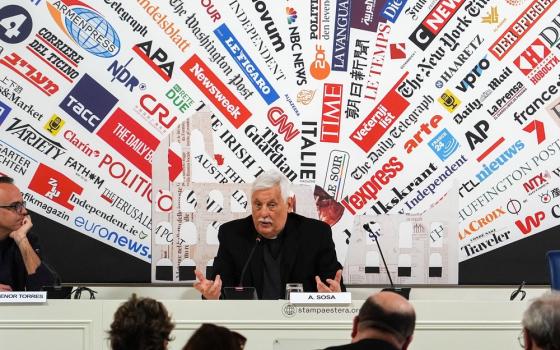
Above every Greek Orthodox church’s altar, Theotokos, or Mary the Mother of Jesus, symbolically watches over the congregation. The figure, with arms outstretched, welcomes visitors and parishioners alike at St. Sophia Greek Orthodox Cathedral near downtown Los Angeles. (Photo courtesy of Creative Commons/Floyd B. Bariscale)
Kyriaki Karidoyanes FitzGerald was an 18-year-old theology student when a priest at Hellenic College Holy Cross Greek Orthodox School in Brookline, Mass., thrust a book into her hands. To her surprise, it was on ancient female deacons.
“The priest told me, 'You’re going to translate these (books),'” FitzGerald recalled of the volumes by a prominent Orthodox theologian who studied the history of ordained women.
FitzGerald, now a professor at Holy Cross, has carved a niche studying the role of women deacons in particular and has worked tirelessly for the right of women to be ordained.
That prospect may now be a giant step closer to reality, since the Patriarch of Alexandria, who presides over the entire Orthodox Church in Africa, followed up on his 2016 decision to reintroduce women deacons and in February appointed six nuns to be subdeaconesses within the church.
In a symbolic ceremony, the patriarch blessed the women and used other religious symbols to effectively restore women’s ordination within Orthodoxy. The move follows years of discussions within different branches of Orthodoxy on whether to reinstitute women deacons, and it comes at a time of growing interest around the issue within the Greek Orthodox Church, the largest Orthodox denomination in the U.S.
James Skedros, dean of Holy Cross seminary and professor of Orthodox history, believes appointing female deacons will have a positive impact by showing people that “there are plenty of ministries in the church that women can and should participate in.”
“When we see that happening to a woman, even if it’s in Alexandria, that’s a powerful image for us Orthodox.”
While women in several Protestant denominations have succeeded in becoming ordained ministers, their sisters in Eastern Orthodox Christianity and the Roman Catholic Church continue to push for recognition and acceptance. While the Orthodox Church says its theology has not changed in centuries, the role of women members is now in flux.
As the executive director of Saint Catherine’s Vision, a religious organization dedicated to women’s ordination, FitzGerald has awaited this moment for almost 40 years.
For decades, she has teamed up with other Orthodox Christians to serve the community, hoping they will one day succeed in reopening the door to women deacons.
A deaconess is the female equivalent of a deacon, who assists the priest and the bishop during church services.
Unlike a priest or a bishop, who presides over worship and Communion, a deacon cannot lead. A priest or bishop must bless deacons before they can lead collective prayers, read from sacred writings in the Bible or give Communion.
According to Skedros, the African appointment is not technically an ordination but it may be a step in that direction.
“It’s very significant because the Church of Alexandria has identified particular ministries in their church for women,” Skedros said. “It’s a big step — not historically but culturally.”
FitzGerald and other supporters of women’s ordination point to ancient women as a precedent. Some became saints and others, such as St. Phoebe, were revered as apostles.
“They could be teaching catechism or assisting in baptisms,” Skedros said of possible future deaconesses. Most importantly, though, he emphasized that the Church of Alexandria has found its specific ministerial need for subdeaconesses.
Other branches of Orthodoxy have yet to tackle whether they should reinstate an old practice or create a new one, said Chris Kolentsas, priest in training at St. Sophia Greek Orthodox Cathedral in Los Angeles. So, he said, the debate continues today among church leaders in America.
The church would have to clarify the purpose of women's deacons before the position could be reintroduced, and that role does not have to be the same as that of the deaconesses in Alexandria.
Marilyn Rouvelas, chair of Orthodox Deacons, a women’s ordination ministry in Virginia, said deaconesses are desperately needed in the U.S.
“It’s hard for a priest to serve an entire community,” said Rouvelas. “They’re already overworked.”
But each branch of Orthodoxy doesn’t necessarily recognize that need. Rouvelas has monitored and contributed to the discussions since 1992. She said women couldn’t be ordained unless the synod of bishops agrees to it.
“It’s a very arduous ladder to climb to convince bishops that the needs of the church are very great and women can help with that need and serve in those capacities,” she said.
It’s taken almost 30 years to get to this point since the Rhodes Conference, which declared that the order of female deacons should be revived.
“It’s sort of like whack-a-mole,” Rouvelas said with a laugh. “We get going with the issue, and they keep whacking us down.”
Part of the issue is that in Orthodoxy becoming a deacon is considered a steppingstone to becoming a priest. But for the most part, the divisiveness arises from confusion over what to do next.
As the talks continue, FitzGerald emphasizes that women’s ordination can only be rejuvenated within the Orthodox Church if it is an organic — not a political — movement.
“The way to do it is with love so the church knows in her bones and being (that female ordination) is right,” FitzGerald said.
Even though discussions seem to be at an impasse, FitzGerald added: “The critical mass is coming. We’re not going back.”


